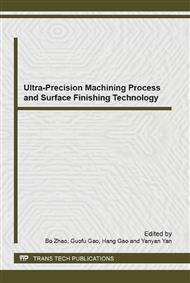p.150
p.159
p.163
p.167
p.171
p.177
p.183
p.187
p.191
Comparison of Fe Catalyst Species in Chemical Mechanical Polishing Based on Fenton Reaction for SiC Wafer
Abstract:
Chemical reaction rate of SiC wafer surface usually determines the material removal rate (MRR) in chemical mechanical polishing (CMP). In this paper, systemic experiments are carried out to discover the relationship between Fe catalyst with different forms or valence and chemical reaction rate based on Fenton reaction. Experimental results show that the MRR changes little using Fe powder or hydrogen peroxide (H2O2) alone, but the MRR of SiC will increase largely by adding them both that will produce Fenton reaction. The MRR continues to increase slightly when Fe2+ ions is employ as catalyst, but that is much lower when utilizing Fe3+ ions. Moreover, SiC wafer with a smaller surface roughness and better quality can be obtained when using Fe powder as catalyst in Fenton reaction. The results indicate that the Fenton reaction can effectively improve the polishing efficiency of SiC substrate and Fe powder is more suitable for polishing of SiC than ferrous or ferric salt in CMP based on Fenton reaction.
Info:
Periodical:
Pages:
171-176
Citation:
Online since:
October 2014
Authors:
Price:
Сopyright:
© 2014 Trans Tech Publications Ltd. All Rights Reserved
Share:
Citation:


